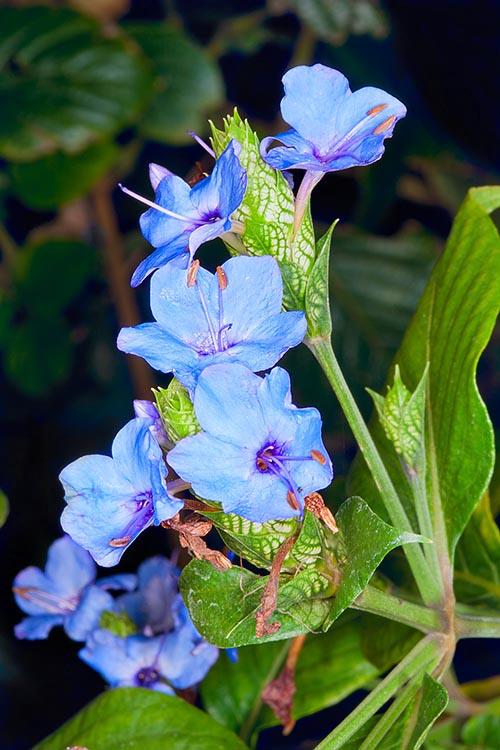Family : Acanthaceae

Text © Pietro Puccio

English translation by Mario Beltramini

Eranthemum pulchellum terminal inflorescences in compact spikes © Giuseppe Mazza
The name of the genus probably comes from the combination of the Greek epithets “ero” = hook, and “anthemon” = flower; the name of the species is the diminutive of the Latin adjective “pulcher”: “pulchellus, a, um” = pretty, cute.
Common names: blue-sage, Indian blue sage (English); gulsham (Hindi); camarão-azul, salva-azul (Portuguese); azulejo (Spanish); neelamulli (Tamil); Blaue Frühlingsblume (German); tinh hoa đẹp, tinh hoa xinh (Vietnamese).
The Eranthemum pulchellum Andrews (1800) is a perennial, evergreen, semi-woody and much ramified shrub, tall up to about 1,5 m, with leaves, with a 0,5-2 cm long petiole, opposite, ovate-lanceolate with pointed apex and entire or slightly toothed (crenulated) margin, 5-10 cm long, of dark green colour and deeply veined.
Terminal inflorescences in compact, from 3 to 10 cm long, spikes with imbricate lanceolate or ovate-elliptic bracts with pointed apex, of white colour with green venations and edges, from which arise blue gentian flowers with funnel-shaped corolla, with thin tube about 2 cm long expanding in five obovate lobes, almost identical, flat, about 1 cm long, and two stamina. The fruits are compressed bilocular capsules, dehiscent (they open spontaneously when ripe), 1,2-1,6 cm long, containing lentil-shaped seeds. It reproduces by seed and by herbaceous cutting in spring in sandy soil kept humid at a temperature of 24-26 °C; it easily self-disseminates, so much as to have naturalized in many tropical areas.
Very appreciated species due to its ornamental foliage and the particular colour of the flowers, besides the long flowering period in winter-spring, cultivable in open air in the tropical, subtropical and marginally warm temperate climate zones, where it can bear occasional, and very short lasting, temperatures just under the 0 °C, even if with damage to the foliage.
Of easy cultivation, it requires a partially shaded position and draining soils rich of organic substance, preferably acidic or neutral, kept humid. It can be utilized as isolated shrub, in mass or for creating borders and low fences. It well adapts to the cultivation in pot for the decoration of verandas, greenhouses and winter gardens utilizing a soil rich of humus with addition of coarse siliceous sand or perlite for improving the drainage, in an as much as possible very luminous position, but avoiding the direct sun, with temperatures not less than 12 °C. Waterings must be regular in summer, more spaced in winter, but without allowing the substratum to dry up too much; after the flowering, in spring, it is to be drastically pruned up to a few centimetres from the base in order to keep a compact habit.
Synonyms: Justicia nervosa Vahl (1804); Eranthemum bicolor Schrank (1817); Eranthemum nervosum (Vahl) R.Br. ex Roem. & Schult. (1817); Eranthemum varians Billb. (1833); Upudalia pulchella (Andrews) Raf. (1838); Eranthemum grandiflorum Zipp. ex Span. (1841); Eranthemum edgeworthianum Nees (1847); Daedalacanthus nervosus (Vahl) T.Anderson (1867); Daedalacanthus scaber T.Anderson (1867); Eranthemum scabrum Wall. ex T.Anderson (1867); Daedalacanthus varians (Vent.) Voss (1895); Pseuderanthemum pulchellum (Andrews) Merr. (1912).
